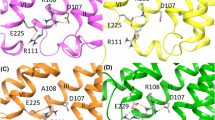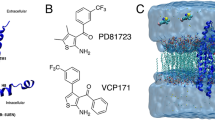Abstract
Homology modeling, molecular docking and molecular dynamics (MD) simulation methods were used to build a reliable model for A1AR (as one of the G protein-coupled receptors—GPCRs) and to explore the structural features and binding mechanism of ligands to this receptor. A model of A1AR was built and inserted in a hydrated lipid bilayer, and 20-ns MD simulation was performed to examine the stability of the best model. In this study, RG-14718 as the best A1AR agonist and bamifylline as a selective antagonist of A1AR have been docked into the active site of the A1AR. After docking, two 20-ns MD simulation was performed on the A1AR–ligand complex to explore effects of the presence of lipid membrane in the vicinity of the A1AR–ligand complex. At the end of the MD simulation, a change in the position and orientation of the ligand in the binding site was observed. This important observation indicated that the application of MD simulation after docking of ligands is useful. Thr270, His278 and Asn70 were crucial residues for hydrogen bonds with these ligands. Phe171, Glu172, Tyr271 and Ile274 were determined to be involved in ligand–receptor binding. The results obtained are in good agreement with most of the site-directed mutagenesis data reported by others. Our results show that molecular modeling and rational drug design for adenosine targets is a possible approach.







Similar content being viewed by others
References
Altschul SF, Madden TL, Schaffer AA, Zhang JH, Zhang Z, Miller W, Lipman DJ (1997) Gapped BLAST and PSI-BLAST: a new generation of protein database search programs. Nucl Acids Res 25:3389–3402
Amadei A, Linssen AB, Berendsen HJC (1993) Essential dynamics of proteins. Proteins 17:412–425
Barbhaiya H, McClain R, Ijzerman A, Rivkees SA (1996) Site-directed mutagenesis of the human A1 adenosine receptor: influences of acidic and hydroxy residues in the first four transmembrane domains on ligand binding. Mol Pharmacol 50:1635–1642
Berendsen HJC, Postma JPM, van Gunsteren WF, Dinola A, Haak JR (1984) Molecular-dynamics with coupling to an external bath. J Chem Phys 81:3684–3690
Bockaert J, Pin JP (1999) Molecular tinkering of G protein-coupled receptors: an evolutionary success. EMBO J 18:1723–1729
Cherezov V, Rosenbaum DM, Hanson MA, Rasmussen SG, Thian FS, Kobilka TS, Choi HJ, Kuhn P, Weis WI, Kobilka BK, Stevens RC (2007) High-resolution crystal structure of an engineered human beta-adrenergic G protein coupled receptor. Science 318:1258–1265
Darden T, York D, Pedersen L (1993) Particle mesh Ewald—An N. Log (N) method for Ewald sums in large systems. J Chem Phys 98:10089–10092
Dawson ES, Wells JN (2001) Determination of amino acid residues that are accessible from the ligand binding crevice in the seventh transmembrane spanning region of the human A1 adenosine receptor. Mol Pharmacol 59:1187–1195
Fisher A, Do RKG, Sali A (2000) Modeling of loops in protein structures. Protein Sci 9:1753–1773
Fredholm BB, Ijzerman AP, Jacobson KA, Klotz KN, Linden J (2001) International union of pharmacology. XXV. Nomenclature and classification of adenosine receptors. Pharmacol Rev 53:527–552
Gao ZG, Jiang Q, Jacobson KA, Ijzerman AP (2000) Site-directed mutagenesis studies of human A(2A) adenosine receptors: involvement of glu(13) and his(278) in ligand binding and sodium modulation. Biochem Pharmacol 60:661–668
Giordanetto F, Fossa P, Menozzi G, Schenone S, Bondavalli F, Ranise A, Mosti L (2003) Exploring the molecular basis of selectivity in A1 adenosine receptors agonists: a case study. J Comput Aided Mol Des 17:39–51
Goddard WA, Kim SK, Li YY, Trzaskowski B, Griffith AR, Abrol R (2010) Predicted 3D structures for adenosine receptors bound to ligands: comparison to the crystal structure. J Struct Biol 170:10–20
Gutierrez-de-Teran H, Centeno NB, Pastor M, Sanz F (2004) Novel approaches for modeling of the A1 adenosine receptor and its agonist binding site. Proteins 54:705–715
Hess B, Bekker H, Berendsen HJC, Fraaije J (1997) LINCS: a linear constraint solver for molecular simulations. J Comput Chem 18:1463–1472
Humphrey W, Dalke A, Schulten K (1996) VMD: visual molecular dynamics. J Mol Graph 14:33–38
Ivanov AA, Baskin II, Palyulin VA, Piccagli L, Baraldi PG, Zefirov NS (2005) Molecular modeling and molecular dynamics simulation of the human A(2B) adenosine receptor. The study of the possible binding modes of the A(2B) receptor antagonists. J Med Chem 48:6813–6820
Ivanov AA, Palyulin VA, Zefirov NS (2007) Computer aided comparative analysis of the binding modes of the adenosine receptor agonists for all known subtypes of adenosine receptors. J Mol Graph Model 25:740–754
Ivetac A, Sansom MSP (2008) Molecular dynamics simulations and membrane protein structure quality. Eur Biophys J 37:403–409
Jaakola VP, Griffith MT, Hanson MA, Cherezov V, Chien EYT, Lane JR, Ijzerman AP, Stevens RC (2008) The 2.6 angstrom crystal structure of a human A (2A) adenosine receptor bound to an antagonist. Science 322:1211–1217
Jason Scholl D, Wells JW (2000) Serine and alanine mutagenesis of the nine native cysteine residues of the human A1 adenosine receptor. Biochem Pharmacol 60:1647–1654
Jiang Q, Lee BX, Glashofer M, van Rhee AM, Jacobson KA (1997) Mutagenesis reveals structure activity parallels between human A2A adenosine receptors and biogenic amine G protein-coupled receptors. J Med Chem 40:2588–2595
Kandt C, Ash WL, Tieleman DP (2007) Setting up and running molecular dynamics simulation of memebrane proteins. Methods 41:475–488
Katritch V, Kufareva I, Abagyan R (2011) Structure based prediction of subtype-selectivity for adenosine receptor antagonists. Neuropharmacology 60:108–115
Kim J, Wess J, van Rhee AM, Schoneberg T, Jacobson KA (1995) Site-directed mutagenesis identifies residues involved in ligand recognition in the human A2a adenosine receptor. J Biol Chem 270:13987–13997
Kim J, Jiang Q, Glashofer M, Yehle S, Wess J, Jacobson KA (1996) Glutamate residues in the second extracellular loop of the human A2a adenosine receptor are required for ligand recognition. Mol Pharmacol 49:683–691
Kolb P, Phan K, Gao Z-G, Marko AC, Sali A, Jacobson KA (2012) Limits of ligand selectivity from docking to models. In silico screening for A1 adenosine receptor antagonists. PLoS ONE 7(11):e49910
Kundu S, Roy D (2008) Temperature-induced unfolding pathway of a type III antifreeze protein: insight from molecular dynamics simulation. J Mol Graph Model 27:88–94
Laskowski RA, Macarthur MW, Moss DS, Thornton JM (1993) PROCHECK—a program to check the stereochemical quality of protein structures. J Appl Crystallogr 26:283–291
Lima FO, Souza GR, Verri WA Jr, Parada CA, Ferreira SH, Cunha FQ, Cunha TM (2010) Direct blockade of inflammatory hypernociception by peripheral A1 adenosine receptors: involvement of the NO/cGMP/PKG/KATP signaling pathway. Pain 151:506–515
Lomize AL, Pogozheva ID, Mosberg HI (1999) Structural organization of G-protein coupled receptors. J Comput Aided Mol Des 13:325–353
Londos C, Cooper DMF, Wolff J (1980) Subclasses of external adenosine receptors. Proc Natl Acad Sci USA 77:2551–2554
Luthy R, Bowie JU, Eisenberg D (1992) Assessment of protein models with 3-dimensional profiles. Nature 356:83–85
Morris GM, Goodsell DS, Halliday RS, Huey R, Hart WE, Belew RK, Olson AJ (1998) Automated docking using a Lamarckian genetic algorithm and an empirical binding free energy function. J Comput Chem 19:1639–1662
Notredame C, Higgins DG, Heringa J (2000) T-Coffee: a novel method for multiple sequence alignments. JMB 302:205–217
Okada T, Sugihara M, Bondar AN, Elstner M, Entel P, Buss V (2004) The Retinal conformation and its environment in rhodopsin in light of a new 2.2 Å crystal structure. J Mol Biol 342:571–583
Olah ME, Ren H, Ostrowski J, Jacobson KA, Stiles GL (1992) Cloning, expression, and characterization of the unique bovine A1 adenosine receptor. Studies on the ligand binding site by site-directed mutagenesis. J Biol Chem 267:10764–10770
Piirainen H, Ashok Y, Nanekar RT, Jaakola VP (2011) Structural features of adenosine receptors: from crystal to function. Biochim Biophys Acta Biomembr 1808(5):1233–1244
Rivail L, Chipot C, Maigret B, Bestel I, Sicsic S, Tarek M (2007) Large-scale molecular dynamics of a G protein-coupled receptor, the human 5-HT4 serotonin receptor, in a lipid bilayer. J Mol Struct (THEOCHEM) 817:19–26
Rivkees SA, Barbhaiya H, Ijzerman AP (1999) Identification of the adenine binding site of the human A1 adenosine receptor. J Biol Chem 274:3617–3621
Sali A, Blundell TL (1993) Comparative protein modeling by satisfaction of spatial restraints. J Mol Biol 234:779–815
Shahlaei M, Madadkar-Sobhani A, Mahnam K, Fassihi A, Saghaie L, Mansourian M (2011a) Homology modeling of human CCR5 and analysis of its binding properties through molecular docking and molecular dynamics simulation. Biochim Biophys Acta Biomembr 1808:802–817
Shahlaei M, Madadkar-Sobhani A, Fassihi A, Saghaie L (2011b) Exploring a model of chemokine receptor/ligand complex in an explicit membrane environment by molecular dynamics simulation: the human CCR1 receptor. J Chem Inf Model 51:2717–2730
Shen MY, Sali A (2006) Statistical potential for assessment and prediction of protein structures. Protein Sci 15:2507–2524
Tieleman DP, MacCallum JL, Ash WL, Kandt C, Xu ZT, Monticelli L (2006) Membrane protein simulations with a united-atom lipid and all-atom protein model: lipid–protein interactions, side chain transfer free energies and model proteins. J Phys: Condens Matter 18:S1221–S1234
Tomai F, Crea F, Gaspardone A, Versaci F, DePaulis R, Polisca P, Chiariello L, Gioffre PA (1996) Effects of A1 adenosine receptor blockade by bamiphylline on ischaemic preconditioning during coronary angioplasty. Eur Heart J 17:846–853
Townsend-Nicholson A, Schofield PR (1994) A threonine residue in the seventh transmembrane domain of the human A1 adenosine receptor mediates specific agonist binding. J Biol Chem 269:2373–2376
Trincavelli ML, Daniele S, Martini C (2010) Adenosine receptors: what we know and what we are learning. Curr Top Med Chem 10:860–877
Tuccinardi T, Ortore G, Manera C, Saccomanni G, Martinelli A (2006) Adenosine receptor modelling. A1/A2a selectivity. Eur J Med Chem 41:321–329
Van der Spoel D, Lindahl E, Hess B, Groenhof G, Mark AE, Berendsen HJC (2005) GROMACS: fast, flexible, and free. J Comput Chem 26:1701–1718
Wallace AC, Laskowski RA, Thornton JM (1995) LIGPLOT—a program to generate schematic diagrams of protein ligand interactions. Protein Eng 8:127–134
Warne T, Serrano-Vega MJ, Baker JG, Moukhametzianov R, Edwards PC, Henderson R, Leslie AGW, Tate CG, Schertler GFX (2008) Structure of a β1-adrenergic G-protein-coupled receptor. Nature 454:486–491
Woolf TB, Roux B (1996) Structure, energetics, and dynamics of lipid-protein interactions: a molecular dynamics study of the gramicidin A channel in a DMPC bilayer. Proteins 24:92–114
Wu B, Chien EYT, Mol CD, Fenalti G, Liu W, Katritch V, Abagyan R, Brooun A, Wells P, Bi FC, Hamel DJ, Kuhn P, Handel TM, Cherezov V, Stevens RC (2010) Structures of the CXCR4 chemokine GPCR with small-molecule and cyclic peptide antagonists. Science 330:1066–1071
Xie KQ, Cao Y, Zhu XZ (2006) Role of the second transmembrane domain of rat adenosine A1 receptor in ligand–receptor interaction. Biochem Pharmacol 71:865–871
Zare B, Madadkar-Sobhani A, Dastmalchi S, Mahmoudian M (2011) Prediction of the human EP1 receptor binding site by homology modeling and molecular dynamics simulation. Sci Pharm 79:793–816
Author information
Authors and Affiliations
Corresponding authors
Electronic supplementary material
Below is the link to the electronic supplementary material.
Rights and permissions
About this article
Cite this article
Mansourian, M., Mahnam, K., Madadkar-Sobhani, A. et al. Insights into the human A1 adenosine receptor from molecular dynamics simulation: structural study in the presence of lipid membrane. Med Chem Res 24, 3645–3659 (2015). https://doi.org/10.1007/s00044-015-1409-6
Received:
Accepted:
Published:
Issue Date:
DOI: https://doi.org/10.1007/s00044-015-1409-6




